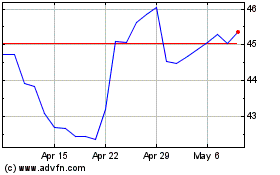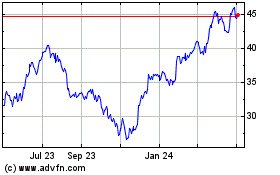A Chevy Bolt Gets You There, but You'll Need a Smartphone to Show You How
April 16 2017 - 7:29AM
Dow Jones News
By Mike Colias
Aiming to please the tech-savvy buyers of Chevrolet's new Bolt
electric car, General Motors Co. equipped it with a 4G Wi-Fi
connection and a 10-inch touch screen. But GM left out one feature
that not long ago was a must-have for many car buyers: built-in
navigation.
Nearly all but the cheapest budget cars sold in the U.S. are
offered with factory-installed navigation at least as an add-on.
Its absence on the $37,500 Bolt is unusual -- and the latest sign
that the ubiquity of smartphones is fundamentally altering how
drivers get around.
Many car owners are taking advantage of larger smartphone
screens by mounting them on the dash or even clutching them in
their hand to monitor a route while driving. Citing safety risks,
car companies in the last two years have responded by equipping
vehicles with Apple Inc.'s CarPlay or Google's Android Auto, which
allow drivers to plug their smartphones into a USB to display the
phone's maps, music and other street-legal features in the
dash.
GM and other car companies typically use CarPlay or Android Auto
as a supplement to factory-installed navigation gear, which has
long served as a lucrative revenue stream. But many consumers say
they no longer bother using the built-in systems.
It is "not as much of a have-to-have feature as it was a few
years ago," said Mike Luner, a general manager at a Fiat Chrysler
Automobiles dealership owned by Del Grande Dealer Group in Northern
California. FCA continues to offer built-in navigation across its
lineup.
Jeff Hawkins, co-founder of hand-held device maker Palm Inc.,
bought a Bolt recently and says the lack of onboard navigation
doesn't bother him because he prefers to use Google Maps on his
Android phone. Mr. Hawkins, now a neuroscientist, said the Google
system offers "superior design, routing and real-time advantages"
to factory navigation.
Built-in navigation systems have advantages. Because they use a
GPS module and software wired into the car, they don't rely on a
wireless connection. That eliminates the risk of losing access if a
signal drops, and minimizes the need to drain smartphone data plans
by using a navigation app.
Still, the car companies' systems have endured tough criticism
for not being updated in real time, requiring dealer support for
updates and lacking crowdsourcing advantages offered by systems
such as Alphabet Inc.'s Waze app.
Waze, for example, aggregates users' location data to detect
backups and route drivers around traffic. Apple Maps lets users
find nearby restaurants and book a reservation through
OpenTable.
GM figured Bolt buyers are savvy and comfortable using the Apple
or Google system, company spokesman Vijay Iyer said. He said the
car also comes with GM's OnStar concierge system, providing vocal
turn-by-turn directions as another option.
GM doesn't plan to phase out navigation offerings in other
vehicle lines. The company plans to eventually integrate additional
location-based features on the Bolt, which comes with a $7,500
federal income-tax rebate for electric car purchases. For example,
CEO Mary Barra last year raised the possibility of a feature that
would help Bolt drivers find the most efficient route between
charging stations to optimize battery life.
While they aren't the moneymakers they once were, factory
navigation systems still rake in profits. Research firm IHS Markit
estimates the systems cost auto makers roughly $450 on average,
while consumers pay between $500 and $1,200. A stand-alone guidance
system may have commanded $2,000 five years ago, but they are
increasingly being bundled into technology packages that include
everything from backup cameras to heated seats.
Analysts expect margins to shrink further as more consumers
discover CarPlay and Android Auto. Introduced less than two years
ago, those systems are available in nearly a quarter of vehicles
produced in North America, IHS estimates. By 2020, that number is
expected to grow to 62%.
Even if today's drivers are finding less reason to pay more for
factory navigation, car companies and suppliers aren't giving up on
them. That is because the self-driving vehicles of the future will
need high-definition maps to navigate roadways.
As autonomous vehicle usage grows, companies are expected to
layer in smarter mapping features based on more accurate
imagery.
The systems will become "more granular and sophisticated," James
Etheridge, a spokesman with Berlin-based mapping company Here
Global BV, said. Here's maps will be "connected to the guts of the
car in a way that smartphones simply are not."
Write to Mike Colias at Mike.Colias@wsj.com
(END) Dow Jones Newswires
April 16, 2017 07:14 ET (11:14 GMT)
Copyright (c) 2017 Dow Jones & Company, Inc.
General Motors (NYSE:GM)
Historical Stock Chart
From Mar 2024 to Apr 2024

General Motors (NYSE:GM)
Historical Stock Chart
From Apr 2023 to Apr 2024
